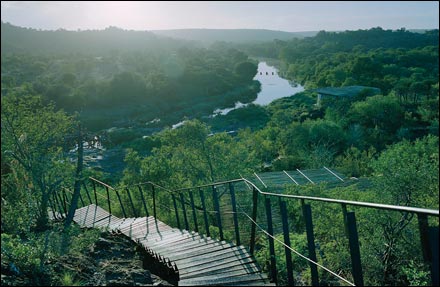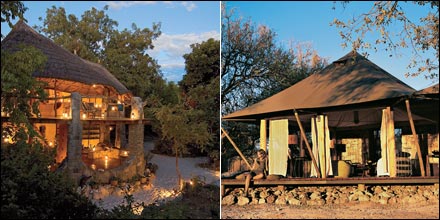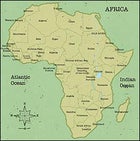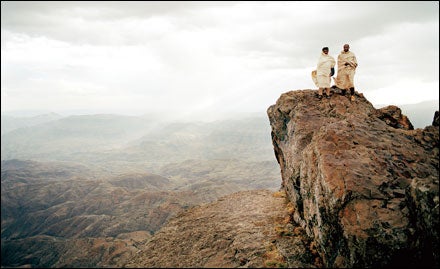Get ready for the new age of adventure on the world's wildest continent. Whether it's the Ugandan National Kayak Team leading raft trips on the raging White Nile or entrepreneurial young guides building stylish bush camps with an eye toward helping local communities, a fresh generation is redefining travel in Africa. Leave your pith helmet at home.
Mozambique: The New “It” Country
South Africa: The New Paradigm
Safari Camps: The New Aesthetic
║┌┴¤│ď╣¤═° Guides: The New Adrenaline
Thrill Seekers: The New ║┌┴¤│ď╣¤═°s
The Isles Have It
After 16 years of civil war, Mozambique is back in the bliss business, with 1,500 miles of Indian Ocean coastline, thriving coral reefs . . . and peace at hand
Fresh Tracks: Hot African Happenings
Festival in the Desert, Mali (January 11 13)
Hunker down Tuareg style two hours from Timbuktu and enjoy all-night throwdowns featuring Malian blues guitar and Africa's top acts on soundstages in the dunes. Tickets, tent, and full board, $375; Adam Skolnick
“Tem for├ža,” said Abudo, in Portuguese. “O vento h├í-de soprar.”
Have strength. The wind will come.
The sail flapped listlessly as we drifted in the sun's growing heat. We'd hired the 70-year-old fisherman to sail us in his wooden dhow across a channel from Ilha de Mo├žambique, a tiny speck off the northern coast, to a nearby isthmus of the mainland. Soon the wind did come, billowing the patched sails of nearby fishing dhows and winging them to sea. Beaching at a thatch village under coconut palms, we waded through tidal inlets to a spectacularly empty, several-mile-long curve of white beach. After snorkeling in the quiet shallows, avoiding enormous sea urchins, we hiked back to discover our dhow sprawled on its side on a sandy flat at least 500 yards from the water's edge.
“What do we do now?” I asked Abudo.
“Now we wait for the sea,” he replied.
╠ř
Back in the fifties and early sixties, Mozambique then a Portuguese colony was on its way to becoming the Caribbean of Africa for white South Africans, landlocked Rhodesians, and others. After Portugal granted independence in 1975 commemorated in Bob Dylan's song “Mozambique” a new black socialist government came to power. Then came 16 brutal years of civil war.
Now, after more than a decade of peace, Mozambique is rebuilding, and tourism is one of its brightest spots. But you don't go there to zoom your crystalline lenses across the African savanna and zing off photos of the Big Five. During the war, bush fighters slaughtered many animals for food, and, as a result, there really isn't much big wildlife in the scrubby interior. Where you do find stunning wildlife is among Mozambique's palmy archipelagoes, coral reefs, and 1,500 miles of Indian Ocean coast that the civil war paradoxically kept pristine from development. Some 700,000 visitors arrive in the country annually (nearly double from 2001), many of them eco-tourists who've quickly spread the word.
During our year's stay in the capital city, Maputo, where my wife, Amy, was doing research on dance, we took advantage of the coastline most weekends. On our children's five-week Christmas school break, we flew deep into the subtropics, 12 degrees south of the equator. It was here, in 2002, that the World Wildlife Fund helped Mozambique establish Quirimbas National Park. This encompasses 11 of the 28 islands of the Quirimbas Archipelago, plus a large swath of the mainland's mangrove and miombo forests and the St. Lazarus Bank farther offshore, considered one of the world's premier diving and sportfishing locations.
The park is an experiment in eco-tourism, approved by the area's traditional fishing villages in order to preserve their way of life, manage marine resources, and develop basic services in a region with a life expectancy of less than 40 years. Rather than bringing in the masses, the park emphasizes limited, high-end tourism. Opened in 2002, the Quilálea Island resort offers elegant thatch-and-stone villas with access to empty beaches and some of the archipelago's best diving right offshore. The Medjumbe Island Resort, also on its own small island, gives easy access to bonefishing and scuba diving. At the Vamizi Island lodge, outside the park on a seven-mile-long island, you can luxuriate in a house-size villa. Backed by European investors, Vamizi collaborates with researchers from the Zoological Society of London to preserve the area's sea turtles and the mainland's elephant habitat.
In the clear waters of another island group, the Bazaruto Archipelago, off the southern coast and protected by a national park, you can swim (if you're lucky) with the threatened dugong a shy sea cow that supposedly inspired the mermaid myth. Upscale lodges here include the Benguerra and the Marlin.
My 51st birthday happened to find us on Ilha de Mo├žambique, which lies partway between the Quirimbas and the Bazarutos. The Portuguese built their stronghold in East Africa on this tiny, 1.5-mile-long sliver of old coral and shipped out the interior's gold and ivory from here. Today there's still no place on earth like Ilha, which has been designated a UNESCO World Heritage site. Tree roots sprout from the broken walls of old coral-and-stone villas in its narrow streets, rusted cannonballs lie about the massive fortress, the tiny chapel of the Southern Hemisphere's oldest church overlooks the sea, and the ornate St. Paul's Palace seems untouched dusty furniture and all since the time of the Portuguese.
European artists and architects are rehabilitating old villas into small hotels. We stayed at the Escondidinho, which had been renovated by an Italian doctor. Under its portico, looking onto a courtyard where it's rumored slaves were once sold, a French ballerina and her computer-engineer partner who chucked it all to move to Africa run a bistro featuring a delicious cuisine that, like the island itself, takes its accents from Africa and Europe, Arabia and India.
At the hour Abudo predicted, the ocean refloated our dhow. Soon we were broad-reaching amid flying spray. We would land just in time for me to join a fast-paced game with Ilha's men's soccer team near the fortress walls. Then I would meet my family in the bistro for kid-goat stew and birthday flan. But for now, it was just the wind and the sea.
Access & Resources
Getting╠řThere:╠řFly South African Airways () from New York to Johannesburg to Maputo for about $1,400 round-trip. From there, it's a two-hour flight on LAM () to Pemba, the launch point for charter flights to the Quirimbas. (For the Bazarutos, flights depart from Vilanculos.) Prime Time: April September, with crowds peaking in August. Where to Stay: The Quil├ílea Island resort has nine villas ($400 per person; 011-258-2-722-1808, ). There are 13 chalets at Medjumbe Island Resort (from $345 per person; closed for renovations until March; 011-27-11-465-6904, ). Vamizi Island lodge has ten beach houses ($560 per person; 011-27-11-884-8869, ). Escondidinho, on Ilha de Mo├žambique, is a ten-room guesthouse (doubles, $50; 011-258-2-661-0078, ). Benguerra Lodge offers 11 chalets ($395 per person; 011-27-11-452-0641, ). There are 19 chalets at the Marlin Lodge (from $213 per person; 011-27-12-460-9410, ).
Peter Stark's book Astoria: John Jacob Astor and Thomas JeffersonÔÇÖs Lost Pacific Empire: A Story of Wealth, Ambition, and Survival will be published in March 2014 by Ecco.
║┌┴¤│ď╣¤═° Capital
More than just the darling of Bono and the Bills, South Africa is breaking down barriersÔÇöfrom cosmopolitan Cape Town to the wild superparks of the future

IT'S THE DREAMLIKE, cinematic power of Africa unfolding yet again. This time, it's late afternoon when the leopard emerges from the bush, 20 feet away, crossing the sandy wash with a lazy stride, pelt rippling in the golden light. Then the radio crackles and we're fishtailing across the 54-square-mile Ngala Private Game Reserve, on Kruger National Park's western edge. Another cat's been spotted, and Jimmy Ndubane, our Shangaan tracker, leads us straight to it. This one is anything but lazy; seconds after we see the white tip of its tail twitching in the grass, the beast leaps forward and zigzags explosively through the meadow. We hear its prey, a mongoose, screaming and, finally, silence. It's awful, it's beautiful, it's what you came for: Africa forever.
However unforgettable, such classic safari epiphanies explain only part of South Africa's allure. You could come for the climbing or surfing, to dive with great white sharks, or to experience the spectacular two-ocean sailing. (The sleek black hull of Shosholoza, South Africa's 2007 America's Cup challenger and the race's first African entrant, was hauled out on the dock across the harbor from my hotel room in Cape Town.) You could come to beat the crowds flooding Johannesburg for the 2010 World Cup soccer finals┬Śthough you'll probably miss Oprah's glittery 2006 New Year's Eve bash.
The best reason, however, is hope┬Śthe dream that things can get better in Africa, that South Africa is leading the way, and that you can be part of it. A dozen years after the nightmare of apartheid, South Africa can still be a tough, bitter environment. But Mandela's vision of a democratic, multiracial African nation is alive and well, and tourism, once the target= of a global boycott, is the fastest-growing area of the economy, providing 1.2 million jobs for the country of 47 million.
On a wide-ranging journey through the nation's wild and urban landscapes, my goal was to max out on the abundant pleasures on offer while witnessing that transformed face. This meant obligatory visits to sprawling, hustling Jo'burg and laid-back, spectacular Cape Town, cities where the street life is set to a booming kwaito beat and revolutionary history is so fresh it's like 1776 was yesterday. South Africa, of course, remains happy to outfit you in khaki, mix you a gin-and-tonic, and make your Hemingway fantasies come true. But in the bush, too, big ideas are taking shape. The first is black empowerment, the integration of economic realms long dominated by whites. The second is South Africa's role in the global movement to create vast “transfrontier” parks that transcend borders while restoring wildlife routes.
Both ideas are being enthusiastically enacted at Tembe Elephant Park, a 190-square-mile preserve just south of Mozambique. The co-owner of Tembe's serene lodge compound, former Durban private detective Ernest Robbertse, manages the operation in partnership with the Tembe tribe. And walls will be coming down: In 1989, war in Mozambique led South Africa to erect an electric border fence, cutting off Tembe's massive 220-strong elephant herd from much of its range. The goal is to remove that barrier, reuniting Tembe's herd with their relatives in Mozambique's Maputo reserve.
An even grander expansion is planned at Kruger National Park, where I took a revelatory, weeklong game drive with naturalist Mike Stephens, experiencing close encounters with lions, rhinos, and a fantastic array of birds. Vast as Kruger may be (it's bigger than Israel), it's part of a pipe-dream-in-the-making called the Great Limpopo Transfrontier Park, which will one day unite Kruger, Mozambique's Limpopo, and Zimbabwe's Gonarezhou in a superpark the size of Maine. “Hopefully,” one official told me, “we'll get herds the size of the Serengeti.”
For now, nothing I saw matched the luxurious wildness of Ngala. The lodge's 20 cottages are unfenced, so you must summon an armed guard if you want to leave your room after dark. This frisson of danger, along with manic four-wheel sprints cross-country looking for game (not allowed in Kruger), adds a keen adrenaline edge. Yet here, too, Ngala quietly preaches the transfrontier vision and, via its support of the Africa Foundation, social justice. In nearby Welverdiend, I saw the foundation's work: new schoolrooms and families piloting “hippo rollers,” easy-to-roll barrels, to the well.
Small steps, small connections. Will South Africa's future include prosperity, huge parks stretching over the horizon, and all its people experiencing Africa's riches, traveling in the footsteps of the wild herds of long ago? All I know is that I'm going back.
Access & Resources
Getting There: Fly to Johannesburg from New York on South African Airways () for about $1,200 round-trip. From there, fly to Durban to see Tembe Elephant Park. Conservation Corporation Africa's Ngala Private Game Reserve () is a two-hour flight from Johannesburg on Federal Air (011-27-11-395-9000, ). Prime Time: ▒Ě┤ă▒╣▒│ż▓˙▒░¨╦╩▓Đ▓╣░¨│Ž│ˇ. Where to Stay: Tembe Elephant Lodge offers ten safari-tent suites for $162 per person (011-27-31-267-0144, ). Ngala's 20 thatched chalets start at $280, including an overnight walking safari (011-27-11-809-4300, ). In Cape Town, try the hip little Kensington Place Hotel (doubles from $190; 011-27-21-424-4744, ), on the slopes of Table Mountain.
Bed, Bush, and Beyond
The latest safari camps aren't only rediscovering the rugged glamour and extravagance of canvas; they're also letting the community in on the action

Hot African Happenings
10-to-4 Mountain Bike Challenge, Kenya (February 17)This 50-mile ride includes a thrilling 6,000-foot technical descent from the Mount Kenya National Reserve to the dry Laikipia plains. Attracting cyclists from across the globe, the race helps fund schools and conservation efforts. $100; ┬Ś┤í.│ž.
Africa

Apoka Lodge // Uganda Good-quality digs were in short supply in Uganda until locals Jonathan Wright and his wife, Pamela, opened the remote Semliki Safari Lodge and Kampala's Emin Pasha Hotel. Now comes their latest addition, Apoka, in the northeast's Kidepo Valley National Park┬Śthe choice place to see cheetahs. Ten elegant tent-cottages outfitted with locally made furnishings look out on the savanna┬Śa landscape traversed by the Karimojong, seminomadic pastoralists who receive a percentage of the lodge revenue and sell their crafts in the lodge store. Doubles from $640; 011-256-41-251-182,
Naibor Camp // Kenya The Art of Ventures, the company that started the groundbreaking Zen-like lodge Shompole in partnership with a group of Masai in southern Kenya, created nearby Naibor in 2004. The camp has recently been moved to the banks of the Talek River in the heart of the Masai Mara Game Reserve, flush with rhinos, cheetahs, hippos, zebras, and tons of birds. Its eight opulent canvas tents with verandas sit in a riverine forest, close to a wildebeest migration route. Doubles from $860; 011-254-20-883-331,
Onguma Camp // Namibia Built just outside Etosha National Park on a 50,000-acre private reserve, the luxury camp at Onguma has seven spacious tents incorporating wood, steel, and stone, all under billowing canvas ceilings. The U-shaped layout of tents, lodge, and a pool allows 24/7 views of a central watering hole. As in Kruger National Park, plans are afoot to remove fences between private reserves alongside Etosha to create one greater park. Doubles from $500; 011-264-61-232-009,
Nkwichi Lodge // Mozambique So lavishly remote is Nkwichi, the only way to reach it is by boat. Hidden on the eastern shore of the vast white-sanded Lake Malawi┬Śone of the world's largest freshwater lakes┬ŚNkwichi's six chalets (each with secluded open-air baths) are surrounded by the 370,000-acre Manda wilderness reserve, the perfect setting for exploring, canoeing, sailing the cerulean waters, or hammock time. The owners have helped the community with everything from growing vegetables to creating the reserve and developing a sustainable environment for tourism. Doubles from $320;
Marataba // South Africa Opened in 2005 on a private concession in Marakele National Park, a few hours north of Johannesburg, this 15-suite camp is owned by the Hunter family, which also runs the excellent Gorah in Addo Elephant Park, in the Eastern Cape. Set in a malaria-free landscape that quickly changes from veldt to mountain, Marataba has stonework reminiscent of African ruins┬Śand huge windows to take in the expanse of Big Five habitat. Doubles from $1,000; 011-27-44-532-7818,
Edo's Camp // Botswana In a 300,000-acre private reserve in the western Kalahari Desert, the four twin-bed tents of Edo's Camp overlook a water hole frequented by antelope and are the latest offering from esteemed outfitter Ker & Downey. Resident guides or the indigenous San people can help you track the seven endangered white rhinos relocated to the reserve from South Africa. Doubles from $660 (closed December through February); 800-423-4236,
Mequat Mariam // Ethiopia A two-bedroom tukul┬Śa round thatch-roofed hut of stone and mud┬Śsits at the edge of a cliff at nearly 10,000 feet, overlooking endless canyonland. This small piece of nowhere is Mequat Mariam, some 400 miles north of Addis Ababa. Mequat and its sister property, Wajela┬Śa seven-hour trek away, with photo ops of baboons┬Śare the work of Tourism in Ethiopia for Sustainable Future Alternatives, which supports nearly 300 local families. From $35 per person; 011-251-11-122-5024,
Sabyinyo Silverback Lodge // Rwanda Virunga Lodge, with its gorgeous vistas of the lakes and volcanoes of Parc National des Volcans, set the standard for comfort in gorilla-watching country, and it will soon have company: the Sabyinyo Silverback Lodge, set to open this spring. The brainchild of the people behind Governors' Camp, in Kenya, Sabyinyo is owned by a trust that helps support 6,000 households in the area. Doubles from $600; 011-254-20-273-4000,
Lupita Island Resort and spa // Tanzania The 14 open-air suites, each with a plunge pool, are carved into a hillside on lush Lupita Island with views across Lake Tanganyika. For off-island awe, take a four-hour drive to Katavi, one of the mainland's most remote savanna parks, or try a two-day trip on a lake cruiser to chimp-filled Mahale Mountain National Park. Doubles from $1,300; 011-255-27-250-8773,
Shumba camp // Zambia Wilderness Safaris, winner of multiple conservation and community-involvement awards, never does things in small measures. So it's no surprise that it opened four camps at once in Kafue National Park, one of the biggest reserves in Africa. All are intimate; the best of the quartet is Shumba, in Kafue's remote northwestern corner. Its six immense safari tents on raised platforms have four-poster beds and inviting couches looking onto sweeping savanna and wetlands. Doubles from $1,480; 800-513-5222,
Additional reporting by Danielle Pergament
Access & Resources
Since these lodges are remote, it's usually wise to book them as part of a bigger, customized itinerary┬Śyour best bet is to have a reputable outfitter plan the logistics for you. Lodges can direct you to favorite outfitters, or you can try these recommended companies (check out the Web sites to see what each specializes in): Abercrombie & Kent (800-554-7094, ), Bushtracks Expeditions (800-995-8689, ), Explore Africa (888-596-6377, ), Ker & Downey (800-423-4236, ), Mango African Safaris (888-698-9220, ), Maniago Safaris (800-923-7422, ), Micato Safaris (800-642-2861, ), Africa ║┌┴¤│ď╣¤═° Company (800-882-9453, ), Uncharted Outposts (888-995-0909, ), Volcanoes Safaris (770-573-2274, ), Wildland ║┌┴¤│ď╣¤═°s (800-345-4453, ).
The Wild Bunch
Nine Stellar guides with new-school safari smartsÔÇöand a commitment to conservationÔÇötake adventure and altruism where they've never been before
Hot African Happenings
Sahara Marathon, Algeria (February 26)Feel the burn (and the beneficence) on this run to raise money for 200,000 Saharawi refugees left homeless by war; a 10K, 5K, and children's race are also offered. $250 covers room, board, fees, and a small donation; ┬Ś┤í.│ž.
Phil West
The Nairobi-based West, 31, who guided for Kenya's Lewa Wildlife Conservancy before striking out on his own, is as passionate about ethnobotany as he is about tracking leopards. His custom-designed East African safaris might include a six-day walk through the Lewa Wildlife Conservancy and two Masai areas, Il Ngwesi and Lekurruki Masai, plus rafting down Kenya's Ewaso Ng'iro River. Like most outfitters, West has arrangements with local tribes and parks, so nights can as easily be spent in a tent or a lodge and days spent ambling or driving.
Grant and Brent Reed
The two South African brothers, Grant, 32, and Brent, 33, come from a family of naturalists┬Śwhich explains their safari savvy and bird and reptile expertise. (Grant has been collecting snakes since he was five.) Cofounders of Letaka Safaris, the brothers offer everything from walking safaris to birdwatching in Botswana. But for a triple shot of adventure, sign up for one of the nine-day Wildguides courses at their Okavango Guiding School. Participants of all skill levels learn how to handle rifles, track animals on foot, and find their way back to camp on their own, while becoming versed in geology, fauna, and conservation issues of the lush Okavango Delta. ,
Endale Teshome
Born in Ethiopia, Teshome, 31, herded goats in the remote Bale Mountains until his teens. After guiding on his own, he joined Ethiopian Rift Valley Safaris, studying his nation's ancient and cultural history along the way. If it's the vastly diverse flora and fauna of the south you want to see, that's his home turf. In the north, Teshome tours rock-hewn churches┬Śplaces few foreigners have seen.
Craig Doria
South African Doria, 44, guided for ten years in Zambia, where he helped create an anti-poaching unit in the national parks, a passion he's carried to Tanzania, his current base. He's written two books about snakes and also collects DNA for wildlife research. His deluxe tented-camp- and lodge-based safaris, tailored to clients' interests, include hikes, driving, sailing, and more.
Derek Shenton
The third generation of his Zambian family to go into guiding and conservation, Shenton, 41, has built two camps, Kaingo and Mwamba, deep in the game-rich South Luangwa National Park, the launchpad for his guided walks and drives. The stylish Kaingo offers big-game close-ups. (Shenton's forte is tracking cats.) Three hours away by foot is the simpler but equally wild Mwamba. Shenton is a founding member of the South Luangwa Conservation Society, which fights poaching, offers job training, and educates children about wildlife.
Peter and Tom Silvester
The Silvester brothers, from Kenya, merge hipness with high ideals. Peter, 42, runs Royal African Safaris, an ultra-luxe outfitter operating in East Africa, Botswana, and South Africa. Frequented by celebs, CEOs, and royalty, RAS specializes in custom itineraries. (Guides usually visit clients in their home country to iron out details.) Guests stay in tented camps or at lodges like Loisaba, a 60,000-acre community ranch run by Tom, 39, who works it in tandem with the local Laikipiak Masai and Samburu and offers clients everything from mountain biking and camel safaris to rafting. A portion of the profits goes to wildlife research and the community. ,
Corbett Bishop
Originally from Texas, Bishop, 35, moved to Tanzania in 1994 to lead trips up Mount Kilimanjaro and, two years later, started a safari company there, offering mobile luxury camping and camel- or donkey-assisted treks. Bishop's most recent project, the two-year-old Ol Tukai Conservancy, funds both community development and conservation projects; it's named for a village in a critical wildlife corridor between Tarangire and Lake Manyara national parks.
Beyond Kakhi
Two-story rapids, hot, spouting lava, a frenzy of sharks, lions in the darkÔÇöif it's thrills you're after, you'll find them in Africa
Hot African Happenings
Pan-African Film Festival, Burkina Faso (February 24┬ľMarch 3)This is Africa's largest film festival, where movies come in languages from all over the continent. Famed Senegalese director Ousmane Sembene and Danny Glover are among the stars who've attended. $20; ┬Ś┤í.│ž.
Rafting
White Nile, Uganda
There's a simple way the guides at Nile River Explorers measure waves on the White Nile: If a 16-foot raft disappears entirely, the wave is about the size of a two-story building. But while the river's 30,000-cubic-feet-per-second flow (roughly three times that of the Colorado) creates monster rapids, there are swimmer-friendly calm spots in between, and NRE's guides include charter members of the Ugandan national kayak team. The 18-mile day trip begins with five Class IV┬ľV rapids, each with placid, crocodile-free pools below. Day trips, $95; luxury tented accommodations at the Nile Porch from $54; 011-256-43-120-236,
Hiking
Ol Doinyo Lengai, Tanzania
Allan Mbaga, Tanzanian owner of African Outdoor Expeditions, has worked with David Breashears and Imax film crews on Kilimanjaro, and he'll take you up Ol Doinyo Lengai, a 9,235-foot peak north of the Ngorongoro Conservation Area. You'll spend two days climbing steeply through volcanic ash and lava rock; near the top, hikers pitch camp in the inactive south crater before exploring the north crater's steaming vents and magma pools. The five-day trek includes a visit to Lake Natron, where flamingos flock by the thousands. $1,900, all-inclusive; 011-255-744-263-170,
Surfing
Southwest Madagascar
This May through October, African Surfaris will guide clients around the planet's fourth-largest island┬Śconsidered one of the last undiscovered surfing outposts. The trip starts in the Toilara Reef region near the southwestern town of Toilara, just 25 miles north of Flame Balls┬Śa hollow 200-yard-long left reef break two miles offshore. Ten-day trips from $1,600, including airfare from Johannesburg, lodging, meals, and boat trips; 011-27-82-836-7597,
Fly-fishing
Zambezi River, Namibia
Cast a fly on the Zambezi, where 15-pound dagger-toothed tiger fish prowl. The posh Impalila Island Lodge, at the confluence of the Chobe and Zambezi rivers, is not only the best place to find the ferocious fish; it's also within striking distance of Victoria Falls and beast-rich Chobe National Park. Seven-day trips with Aardvark McLeod from $4,000, all-inclusive, from Johannesburg; 011-44-1980-840-590,
Lion Tracking
Tsavo East National Park, Kenya
In 1898, two lions ate scores of railroad workers near what is now Tsavo East National Park. Today, area lions regularly kill livestock in nearby settlements, which is why in 2002 Earthwatch Institute launched its Lions of Tsavo program. Volunteers join American and Kenyan scientists to track and study the cats during night drives in order to help people and prides coexist. Thirteen-day trips from $3,249; 800-776-0188,
Horse Trekking
Malawi and Zambia
This fall, Malawi and Zambia are set to create the Nyika Transfrontier Conservation Area, a 13,500-square-mile international peace park. The best way to explore this remote region is by horseback on a mobile safari: two nights at the upscale Chelinda Lodge, followed by a week of galloping through montane grasslands and forested valleys, and hoofing it to the top of 8,553-foot Nganda Mountain. Ten-day trips from May through October, $3,090, including lodging, meals, and riding; 011-44-1-837-82544,
Diving
Port St. Johns, South Africa
Each winter, as the water temperature drops along South Africa's eastern coast, millions of sardines rocket the 300 miles from East London to Durban┬Śserving as the main course for sharks, seals, whales, and superpods of 5,000-plus common dolphins. June and July are the best months to catch the frenzy. Six-day dive trips from $1,800, including lodging, diving, and meals at iNtaba River Lodge; 011-27-21-782-2205,



